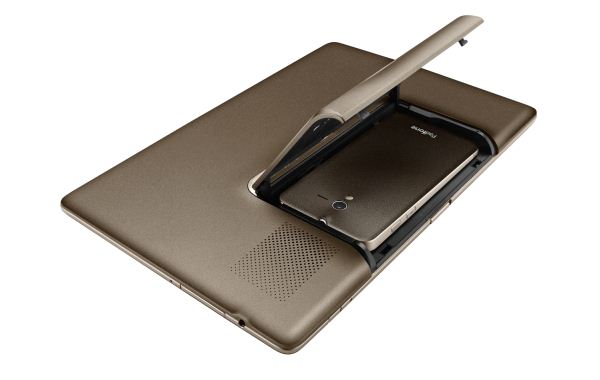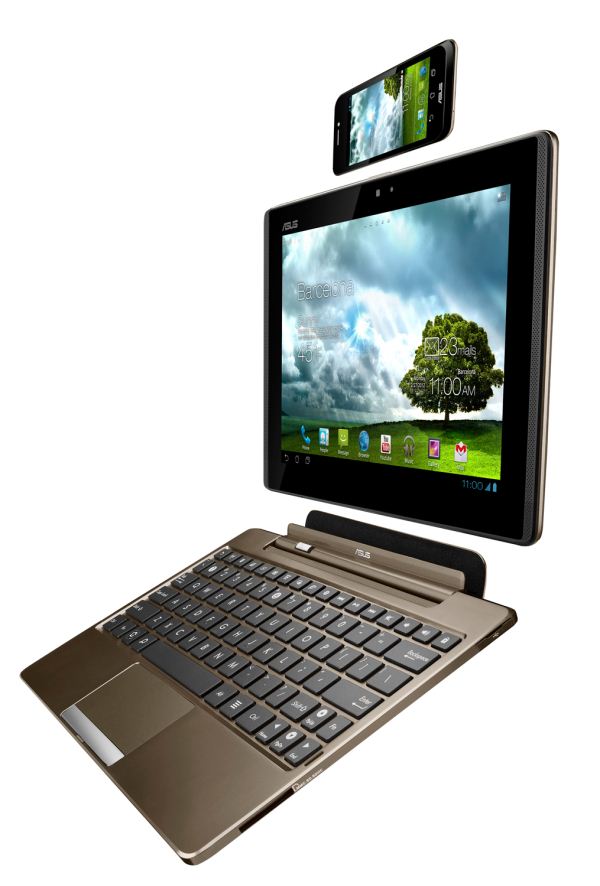ASUS Reveals Padfone Specifications
by Anand Lal Shimpi on February 27, 2012 5:30 AM EST- Posted in
- Smartphones
- Asus
- Mobile
- Padfone
- Tablets
ASUS has been talking about its Padfone product for quite a while now but we're finally getting some more detailed specs on it. As a recap, Padfone is a smartphone that can dock into a tablet, which can then dock onto a keyboard to build a ultraportable netbook/notebook.
The Padfone itself is based on Qualcomm's Snapdragon S4, although it's not clear what S4 model number is being used. The MSM8960 would obviously make sense, but since ASUS isn't listing LTE connectivity as a feature it could easily be the MSM8260A. The 4.3-inch display features a qHD resolution, although when docked into the Padfone station you get a 10.1-inch 1280 x 800 IPS panel driven by the phone.
| ASUS Padfone Specifications | ||||||
| ASUS Padfone | ||||||
| Networks |
WCDMA 900/2100MHz |
|||||
| OS | Android 4.0 (ICS) | |||||
| CPU | Snapdragon S4 (dual-core Krait) with Adreno 225 GPU | |||||
| Memory | 1GB LPDDR2 RAM + 16 - 64GB eMMC NAND | |||||
| Connectivity | 802.11b/g/n, Bluetooth 4.0, 3.5mm audio jack, microUSB 2.0 | |||||
| Display | 4.3-inch Super AMOLED qHD (960 x 540) | |||||
| Camera |
Rear: 8MP F2.2, AF with LED Flash Front: VGA |
|||||
| Others | Motion sensor, proximity light sensor, gyro sensor, e-compass | |||||
| Battery | 1520mAh Li-ion | |||||
| Expansion Slot | microSD (SDHC/SDXC up to 32GB) | |||||
| Dimensions | 128mm x 65.4mm x 9.2mm | |||||
| Weight | 129g | |||||
The Padfone station adds a 24.4Whr battery which should increase battery life tremendously. The flexibility of the Padfone platform is certainly unique and it's good to see ASUS experimenting with new form factors and usage models as it expands its position in the mobile industry. It's still not entirely clear what the ideal mobile device is. There are obvious benefits to having a smartphone, tablet or notebook. The Padfone tries to give you all three in a single platform. Conceptually it makes sense, how well it works in practice is only partially in ASUS' hands. The hardware aspect must be properly executed but there's also the software component. Seamless transitions between the different usage modes is important, but there's also the question of whether or not Android is ready for prime time as a notebook OS. I think it's safe to say that as a smartphone and tablet OS Android is doing quite well, but its usefulness as a notebook OS is still up for debate depending on what you do. If the TF Prime + dock is an option in your eyes, the Padfone is definitely an even more flexible alternative.
| ASUS Padfone Station Specifications | ||||||
| ASUS Padfone Station | ||||||
| Connection Interface |
Micro USB + Micro HDMI |
|||||
| Display | 10.1-inch 1280 x 800 with Capacative Touch | |||||
| Camera |
Rear 8MP (via Padfone rear camera) Front 1.3MP (1280 x 800) |
|||||
| Others | Vibration sensor, 2 color LED indicators for battery status | |||||
| Battery | 24.4Whr | |||||
| IO | 2-in-1 audio jack, 40-pin connector | |||||
| External Antenna | Phone/GPS | |||||
| Dimensions | 273mm x 176.9mm x 13.65mm (h-average) | |||||
| Weight | 724g | |||||
As Microsoft heads toward a more unified OS strategy across smartphones, tablets and PCs, a Windows 8 based Padfone may be an interesting option...












10 Comments
View All Comments
Conficio - Monday, February 27, 2012 - link
I was waiting for such a design all along.Although the details on this one seem to be a bit unpractical. Especially the flap to dock the phone, seems to be prone to break and unwieldy to handle. I'd like to see an open slot where you simply slot the phone into and secure with some spring loaded mechanisms. That could/should also enable antenna diversity in the larger screen for faster Wifi and may be even LTE/GSM reception.
I'm also missing an option to combine the phone and keyboard alone and use a display over air connection to a separate display (TV). That would come in really handy in hotels.
The third development I'd like to see is such docking integrated into regular keyboards, which should mean I can dock my phone into the PC and can access seamlessly its data (files, contacts, documents, ability to call, e-mail, etc.) In regular keyboards I could see this being used as the track pad or an extra screen for short cuts or other purposes.
Ideally all those dockings would finally be standardized to interoperate. Image you can walk into a hotel and slot in your phone into a keyboard/screen combination and access your personal environment in the cloud. Its you setup where. In an office you'd have the same.
StarrWulfe - Monday, February 27, 2012 - link
If you look at the side of the phone, you'll notice there's 3 gold contacts in addition to the USB and HDMI jacks. These line up with 3 pins in the padstation. these are antenna connections, and I'm sure there's a wifi and GSM antenna surrounding the display there.djc208 - Monday, February 27, 2012 - link
With all the cell companies going to limited data plans, unless the cell companies start to let you use your "bucket o' data" on any device you wish (like they should) this is going to be a much better idea for many, plus a pretty logical extension.With this you don't have to pay for multiple data plans, or to use tethering on your smart phone. Plus while many things will sync over the net now not everything does, so with this type of device everything is there and only once device needs to be synced or maintained.
Agree that Android may not be ready for laptop use but I always thought the phone/tablet combo made sense.
bleh0 - Monday, February 27, 2012 - link
An Apollo Window Phone 8 and Windows 8 tablet version would be very appealing to me. Design wise it isn't perfect but the idea itself is good.Arsynic - Monday, February 27, 2012 - link
#1 The "docking" is crude as hell. Open up a flap and put the phone in. It looks stupid and it's just one more thing to break off. The phone needs to snap into the back and be flush with the back of the unit.#2. The "tablet" is fully functional. Why the hell would you spend $500 on a tablet and $200 on the phone and then $150 for the dock? The "tablet" should just be a dumb screen that you can purchase for $100 and you simply snap the phone in and it becomes a tablet.
#3. Is ICS "Context Aware"? Tablet apps and phone apps are sometimes not the same. Can ICS tell the difference between the device being in "Tablet Mode" and "Phone Mode" and changing the computing environment (and requirements) based on the context that the device is being used in?
This is a nice first try, but it looks like a first try.
Disorganise - Monday, February 27, 2012 - link
"The 4.3-inch display features a qHD resolution, although when docked into the Padfone station you get a 10.1-inch 1280 x 800 IPS panel driven by the phone."not sure where you got 'fully functional tablet" from, it reads to me like it's exactly as you suggest - a dumb screen with battery.
Since the phone has all the smarts and has to be able to drive a 'big' screen, I imagine battery life isn't going to be great in phone mode - unless it underclocks itself or something
I can see how docking he phone is moderately more convenient than wifi-ing your phone to provide 3/4G since it'd be automated and the phone gets charged - but it does add weight to the devce in your hands.
Presumeably, the keyboard will add another 22Wh battery like it does for the Prime.
Then there's the question of answering an incoming call (assuming no bluetooth headset) - you'd either have to use the tablet which makes look like a dork, or fiddle around trying to get the phone from the dock.
albnok - Tuesday, February 28, 2012 - link
#3 - Yes, Android has always been context aware. When you put your phone on a dock, or plug a 1280x800 tablet to a HDTV (making it 1280x720), or rotate the device, or change the screen size, or change the locale, or enable the virtual keyboard, it is considered a "configuration change" and the app will be redrawn accordingly.This is only a problem IF the developer uploads an APK for Android 2 devices and a separate APK for Android 3 devices. I assume the PadFone identifies itself to the Market as a phone when outside the dock, and as a tablet when inside the dock. Asus already thought of this in another video which shows the App Drawer - in between APPS and WIDGETS there is a "FOR PAD ONLY" tab, which I assume is for the Android 3 apps, which are not designed for phones.
Anonymous Blowhard - Monday, February 27, 2012 - link
Also, I recall ASUS saying that the tablet would be functional separately. Is this still true, or is it just a battery, screen, and shell vis-a-vis Motorola's Lapdock series?(Now there was a concept that needed more exploration.)
snoozemode - Monday, February 27, 2012 - link
It's just a dumb screen. Won't function w/o phone.Flyguy2929 - Thursday, March 1, 2012 - link
TMobile is the only choice. ATT will tack on a tethering charge as they did with the RIM Playbook